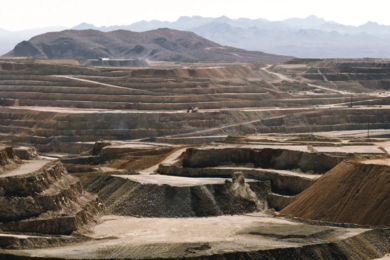 Seabridge Gold’s 19,000 m core drill program at its 100%-owned KSM project in northwest British Columbia, Canada, will focus on expanding last year’s Deep Kerr core zone discovery and following up on the strong evidence supporting a potential second core zone discovery at Iron Cap. The highly successful 2013 program at KSM concentrated on finding an expected higher grade core zone beneath the Kerr deposit. This program resulted in the discovery of Deep Kerr and culminated in an initial inferred resource estimate at Deep Kerr totalling 515 Mt grading 0.53% Cu and 0.36 g/t Au – the highest combined metal values found to date at KSM. Last year’s program also found more evidence of a possible second higher grade core zone beneath the Iron Cap deposit.
Seabridge Gold’s 19,000 m core drill program at its 100%-owned KSM project in northwest British Columbia, Canada, will focus on expanding last year’s Deep Kerr core zone discovery and following up on the strong evidence supporting a potential second core zone discovery at Iron Cap. The highly successful 2013 program at KSM concentrated on finding an expected higher grade core zone beneath the Kerr deposit. This program resulted in the discovery of Deep Kerr and culminated in an initial inferred resource estimate at Deep Kerr totalling 515 Mt grading 0.53% Cu and 0.36 g/t Au – the highest combined metal values found to date at KSM. Last year’s program also found more evidence of a possible second higher grade core zone beneath the Iron Cap deposit.
The KSM Project is a mining district hosting multiple deposits containing one of the largest known undeveloped gold and copper reserves in the world. Its composite intrusive complex hosts four known, large gold-copper porphyry deposits with demonstrated vertical continuity down to near-magmatic bornite-bearing core zones and upward through voluminous mineralised stockworks into near surface epithermal vein deposits. “This vertical zonation is typical of many of the world’s largest mining districts,” the company reports. In 2012, Seabridge concluded that the entire sequence of zones likely existed intact on its claims, leading to a concentrated search for core zones below the known porphyry deposits. Core zones typically represent deposits formed under higher temperature and pressure conditions, resulting in a mineralogical character usually associated with significantly higher metal content.
Chairman and CEO Rudi Fronk commented that “our team is very excited about the potential for this year’s program. The Deep Kerr core zone discovery in 2013 confirmed our thinking about KSM-that movement along the various faults has not been enough to displace the core zones beyond our reach. Our success at Deep Kerr has also taught us how to look for more of these zones. Our first priority remains Deep Kerr, where we believe there is much more to come. We are confident that we can significantly increase the size of the Deep Kerr resource while also potentially improving its average grade. We also think we can find more core zones and that is our second priority for this year’s program.”
Fronk noted that Iron Cap is especially well located for a second core zone discovery; it is the closest deposit to proposed infrastructure and mine plans already assume that it will be exploited from underground using block cave methods. “We think that, at Iron Cap, we may right now be where we were last year at this time with Deep Kerr. The last holes drilled at Iron Cap in 2013 generated well-mineralised intercepts up to 850 m long as well as some exceptional grades directly below existing resources including 51 m containing 1.38 g/t Au and more than half a percent of copper. We appear to be closing in on a significant discovery that may be more gold rich than Deep Kerr.”
With the addition of Deep Kerr, Seabridge believes that KSM is now a top-tier copper project with grades that invite comparison with the world’s largest and most profitable operating copper-gold mines. While Deep Kerr was the principal focus of exploration work in 2013, the limits of the zone were not defined. The deposit remains open to the north and at depth, with the best results encountered at the end of the 2013 program towards the north end. The deposit is trending into the Sulphurets valley which may bring it closer to the surface and expedite drilling.
The Deep Kerr drill program envisions completing between eight and 12 core drill holes along the strike of Deep Kerr to the north. Directional drilling technology will again be employed in an effort to minimise the time required to advance a drill intersection through the target zone. It is also anticipated some drilling will be directed to evaluating the depth limits of the deposit.
Resistivity profiles along the plunge projection of the Kerr deposit were effective at identifying the characteristics that led to the discovery of Deep Kerr. This success will be used as a template for additional geophysical surveys to help define the targeting of additional core zones. Exploration at KSM has tested several core zone targets over the past three years; integrating this drill core data with newly obtained high resolution physical property data is expected to narrow and refine core zone targets effectively. The new program of high resolution physical property measurements will focus on areas encompassing the dip projections of the Iron Cap and Mitchell deposits as well as the direction of the regional plunge for the McQuillan target. Work programs will begin in May with drilling expected to start by early June.
Seabridge holds a 100% interest in several North American gold resource projects. The Company’s principal assets are the KSM property located near Stewart, British Columbia, Canada and the Courageous Lake gold project located in Canada’s Northwest Territories.









